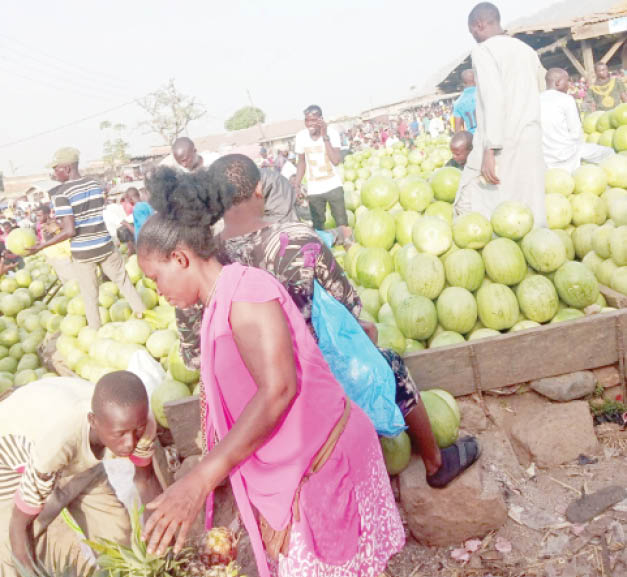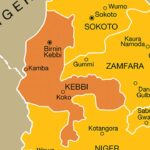Watermelon farming is money-spinning but at a great risk, especially for new farmers who venture into it without much knowledge.
A watermelon farmer in Edo State, Joel Usiagu, told Daily Trust on Sunday that their greatest challenge was water.
To optimize watermelon farming and minimize the risks, adopting modern technology can make a significant difference. By using smart farming software for precision crop monitoring, farmers can track soil moisture, weather patterns, and other critical factors in real-time. This technology enables better decision-making, especially regarding irrigation management, which is crucial for watermelon farming, as it requires balanced water supply. With the help of such tools, farmers can improve their yields, reduce losses, and efficiently manage their farms, ensuring a higher return on investment, even during off-peak seasons.
“Watermelon doesn’t need too much water; it doesn’t also take little water, all it needs is average water to grow well,” he said.
Usiagu, who is the chairman of the All Farmers Association (AFAN), Edo State chapter, said the best planting time for watermelon was the earliest time of the rainy season and towards the end of the season.
Over 200, 000 Niger farmers to benefit from Tinubu Agro-Commodity programme
How Zaria PHCs operate in unsecured environment
“That is why we plant in March when the rain is starting and November when the rain is going.
“If farmers plant during the peak of the rainy season, it will not do well because it doesn’t require too much water like cucumber and other crops one can plant any time of the rainy season,” he said.
He said a first timer should start small because of the attendant challenges and risks involved, noting, “It can make a farmer rich and also make him or her poor.
“Last year, I cultivated 15 hectares but herdsmen ravaged the farm with cows, and over N3 million was wasted, so anybody coming for the first time can start with one acre, which can still give a substantial profit,” he said.
He said the reason to start with small acres was to enable the farmer manage it because of pests.
“It is better to start small so that you don’t suffer heavy loss. You must plant hybrid seeds for better yield.
“So, make sure you plant in a soil that drains water rather than the one retaining water because the plant can take the water and it will evaporate, but if you plant in water log or clay soil, the watermelon will not do well. A well drained soil is best for watermelon.
“A first time watermelon farmer should acquire a land, clear it, and in preparation, one can plough and harrow. Ploughing breaks the soil while harrowing is to smoothen it, but if you can’t do the two, you can plough and begin planting,” he said.
Usiagu advised that in planting, farmers should give space, like a foot or foot and half because watermelon is a creeping plant; and the more it has space to creep, the more it produces many bulbs.
“On one hectare, which is about 10,000 square meters, you can plant 1,000, 1,500 or a maximum of 2,000. But 1,000 or 1,500 seeds per hectare is better so that it will have enough space to creep. It is when they are creeping and not disturbed by weed that they produce better.
“That one hectare with 1,000 seedlings can give you 6,000 bulbs when each seed produces average of six bulbs, and If you sell each bulb at N500, that is N3 million, so it is a profitable business. It can even give you more than six bulbs.
“The best time to plant is dry season if there is a source of water supply. We can’t compete with Arewa farmers in watermelon farming because they harvest hundreds of trailers. So, for us here, off season is the best.
“When Arewa farmers are harvesting, there would be gloat in the market and price would crash. We can compete with them in terms of yield, but if you farm during the off season, by the time we are harvesting, they have already harvested, and there would be no competition,” he advised.
He continued, “When you plant by March, by May when the rain is at its peak you would be harvesting. Too much rain is not good for watermelon.
“You plant two or three seeds per hole so that at least one can germinate, even when there is pest attack.”
He said that after preparing the land, the farmer should spray insecticides to control insect that may come to suck the nectar or flower.
“A farmer can spray insecticide or herbicide to keep the weed off the ground so as to give time for the seed to germinate before weed can compete with it.
“Herbicides are good because it would keep the weed off the soil for three to four weeks, and that would give the plant enough time to grow without competition from weed.
“A lot of people use insecticide to control weeds, but hand weeding is the best because it will expose the soil so that water can creep into it to give room to produce more bulbs.
“A seed of watermelon, if it grows well, can give five, six or 10 bulbs. Watermelon bulbs are in different categories – large, extra-large, number one and number two.
“After planting you start giving the soil treatment every week with fertilisers so as to get better yield, but here in Edo, we don’t use fertiliser because our soil is fertile.
He said watermelon farmers were not getting inputs from the government because it is not among the cardinal crops.
In Edo, the focus of the government is beans, soybeans, rice, cassava and lives stock. So, watermelon is not one of the priority crops here. But farmers can form cooperatives to be able to access funds from microfinance and development banks.
Usiagu, however, advised first time watermelon farmers to think big and start small so that they would learn from their mistakes and grow.

 Join Daily Trust WhatsApp Community For Quick Access To News and Happenings Around You.
Join Daily Trust WhatsApp Community For Quick Access To News and Happenings Around You.


